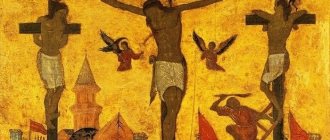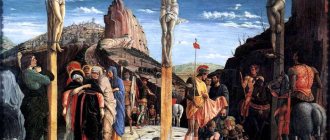Conversation between Christ and the Samaritan woman. Story
The fifth week of Easter in church services is dedicated to the memory of the Savior’s conversation with the Samaritan woman. Returning from Judea to Galilee, Jesus Christ and His disciples passed through the Samaritan country. The Assyrian king Shalmaneser conquered the Israelites and took them into captivity, and in their place he settled pagans from Babylon and other places. From the mixing of these settlers with the remaining Jews, the Samaritans arose. The Samaritans accepted the Pentateuch of Moses, but did not forget their gods. When the Jews returned from Babylonian captivity and began to rebuild the Jerusalem temple, the Samaritans also wanted to take part in this, but the Jews did not allow them, and therefore they built themselves a separate temple on Mount Gerizim. Having accepted the books of Moses, the Samaritans, however, rejected the writings of the prophets and all traditions, and for this the Jews treated them worse than the pagans, in every possible way avoided any communication with them, abhorring and despising them.
Passing through the Samaritan country, the Lord and His disciples stopped to rest near a well, which, according to legend, was dug by Jacob. At noon, during a great heat, a woman came to the well to draw water. The disciples of Jesus went to the city for food, and He turned to the Samaritan woman with the request: “Give Me a drink.” Having learned, perhaps by clothing or by manner of speech, that the one addressing her was a Jew, the Samaritan woman expressed her surprise that He, being a Jew, was asking her, a Samaritan woman, for a drink, meaning the contempt that the Jews showed towards the Samaritans. But Jesus tells the woman that she would not ask such a question, knowing who is speaking to her and what happiness God sent her in this meeting. If she knew who was asking her for a drink, then she herself would have asked Him to quench her spiritual thirst, to reveal to her the truth that all people strive to know; and He would give her “living water” (John 7:38-39). The Samaritan woman did not understand the Lord: she thought that he meant spring water, which is at the bottom of the well, and therefore asked Jesus where He could have living water from, if He had nothing to draw with, and the well was deep. “Are You greater than our father Jacob, who gave us this well and drank from it, and his children and his cattle?” (John 4:12). Then the Lord said:
Everyone who drinks this water will thirst again, but whoever drinks the water that I will give him will never thirst; but the water that I will give him will become in him a fountain of water springing up into eternal life (John 4:13-14).
The Samaritan woman did not understand these words of the Savior and said: “Sir! Give me this water so that I won’t be thirsty and won’t have to come here to draw.” Christ, wanting the Samaritan woman to understand what He was talking to her about, first told her to call her husband to Him. The woman said: “I don’t have a husband.” Then Jesus Christ said to her: “You said the truth that you have no husband. Because you had five husbands; and the one you have now is not your husband; It’s true what you said.” The Samaritan woman, amazed at the omniscience of the Savior who had revealed her entire life, now realized that she was not speaking to an ordinary person. She immediately turned to Him to resolve the long-standing dispute between the Samaritans and the Jews: whose faith is more correct and whose service is more pleasing to God. "God! I see that You are a prophet,” she said, “our fathers worshiped on this mountain; and you say that the place where one should worship is in Jerusalem.” The Lord answers the Samaritan woman’s question that it would be wrong to think that God can be worshiped only in one specific place, and the controversial issue between the Samaritans and Jews will soon lose its meaning by itself, because both types of worship - both Jewish and Samaritan - will cease in the near future. This prediction was fulfilled when the Samaritans, exterminated by wars, became unconvinced of the significance of their mountain, and Jerusalem was destroyed by the Romans and the temple was burned in the 70th year after the Nativity of Christ. The Samaritan woman understood the meaning of Jesus’ words and said: “I know that the Messiah, that is, Christ, will come; when He comes, He will tell us everything.” The Samaritans also expected the Messiah. They looked to Him for a prophet, not a leader. Therefore, Jesus, who for a long time did not call himself the Messiah among the Jews, directly tells this simple Samaritan woman that He is the Messiah-Christ promised by Moses. Delighted with happiness that she sees the Messiah, the Samaritan woman throws her waterpot at the well and hurries to the city to announce to everyone about the coming of the Messiah, Who, as the Knower of the Heart, told her everything that she had done. His disciples who came at this time were surprised that their Teacher was talking with a woman. However, in awe of their Teacher, the disciples did not express their surprise in any way and only asked Him to taste the food they had brought. But He answered them:
I have food that you do not know (John 4:32).
The disciples did not understand His words, not daring to question Him further, they said to each other: “Who brought Him anything to eat?” (John 4:33). Jesus, seeing their surprise, explains to them His first words:
My food is to do the will of Him who sent Me and to finish His work (John 4:34).
He does not think about hunger and thirst, not about heat and fatigue, not about midday rest and lunch in these sacred moments. Now His soul is with God, Who sent Him; now His whole spirit is immersed in the great work that the Father has entrusted to Him. The Samaritans hurried across the field to Him. Therefore He continues: “Do you not say at the time of sowing: four more months, and the harvest will come” (John 4:35). Meanwhile the Samaritans approached. They believed the woman's testimony and asked Jesus to stay with them. He stayed with them for two days, and this time was filled with fruits and blessings. If they had previously believed in Him at the word of the woman, now they believed in His word, because they themselves knew and experienced that He is the Messiah, the Savior of the world.
The Samaritan woman whom Christ met at the well bore the name Photinia. She became a Christian and was martyred in Rome in 66. Together with her, her sons Josiah and Victor, as well as sisters Anafrolia, Paraskovia, Kyriakia, Fota and Afotina, suffered for Christ. Photinia is commemorated on April 2 (March 20, O.S.). The remembrance of the Savior’s conversation with Photinia of the Samaritan about living water, His divine and saving teachings takes place on the fifth Sunday after Easter.
Interpretations
Scholars have noted that this story appears to be based on the standard betrothal 'type scene' from Hebrew scriptures, particularly Jacob in Genesis 29.[8] This convention, which would be familiar to Jewish readers, follows from an earlier scene in which John the Baptist compares his relationship with Jesus to that of a groom's friend.[1] Jo-Ann A. Brant, for example, concludes that "there is almost unanimous agreement among literary critics that the scene at Jacob's Well conforms to the conventions of the typical betrothal scene found in Hebrew narrative."[9] Other scholars have noted significant differences between John 4 and the betrothal scenes in the Hebrew Bible.[10][11] For example, Dorothy A. Lee lists several inconsistencies between the Hebrew betrothal scenes and John 4: “The Samaritan woman is not a young Hebrew virgin, and no betrothal occurs; the well is not associated with sexual fertility, but is an image of salvation (see Isa. 12: 3); Jesus is presented not as the bridegroom, but as the giver of living water."[12]
This Gospel episode is referred to as "a paradigm for our connection to truth" in the Roman Curia book Christian Reflections on the New Age
, as the dialogue says: “You bow to what you do not know; we bow to what we know,” and offers the example of “Jesus Christ, the bearer of the water of life.”[13] The passages making up John 4:10–26 are sometimes called the Discourse on the Water of Life, which is a complement to the Discourse on the Bread of Life.[14]
In Eastern Christian tradition, the woman's name at the time of her encounter with Jesus is unknown, although she was later baptized "Photini". She is celebrated as a famous saint. As further recounted in John 4:28–30 and John 4:39–42, she quickly spread the news of her meeting with Jesus, and because of this, many believed in Him. Her constant witness is said to have brought so many people to the Christian faith that she is described as "equal to the apostles." Eventually coming to the attention of Emperor Nero, she was brought before him to answer for her faith, enduring many tortures and dying a martyr's death after being thrown into a dry well. She is remembered on the Sunday four weeks after Easter, which is known as "Samaritan Sunday."
In Oaxaca, Oaxaca, Mexico, the celebration of the Samaritan woman takes place on the fourth Friday of Lent. On this day, churches, schools and businesses distribute fruit drinks to passers-by.[15]
Week about the Samaritan. Troparion, Kontakion and Canon
Troparion:
Bright Sunday sermon, t ѓнГла ўвдніжнўні ўчн7ціти, и3 њздніжьњ the Judgment tverg8shіi, ґпстлвмъ praising z glaha, and 3proverzzz death, rise хрт0съ bG ъ, grant great mercy to the world.
Kontakion:
By faith, having come to the source of Samara, you will see the greatness of the world. and 3 the kingdom of Vhshnzgw, inheriting forever, ever-glorious.
Library of the Russian Faith Canon for the Week of the Samaritan →
Read online
Conversation between Christ and the Samaritan woman. Icons
The plot of the conversation between Jesus Christ and the Samaritan woman is one of the most common images in early Christian art. At the well there is a figure of a woman taking a vessel of water from it, and on the other side of the well is the Savior talking with a woman. The earliest images of this subject include: a fresco of a church house in Dura Europos (c. 250, only the figure of a Samaritan woman has survived), frescoes of the Pretextata catacombs on Via Latina (IV century), a relief on an ivory plate on the See of Maximian (VI century) ).
Jesus and the Samaritan woman. Rome, Via Latina catacomb fresco. III-IV centuries
Since the 6th century, there has been a change in the depiction of the composition - Jesus Christ is depicted sitting near a well (for example, the mosaic of the Ravenna church of Sant'Apollinare Nuovo, 6th century). By the 12th-14th centuries, icon painting in the scene of Christ’s conversation with the Samaritan woman began to emphasize its teaching significance (for example, the painting of the Novgorod church of Theodore Stratilates on the Stream, 1380s).
Conversation between Christ and the Samaritan woman. Italy, Ravenna, VI century
Martyr Photinia the Samaritan. Modern icon
Christ and the Samaritan woman. Double-sided icon-tablet, reverse - “Healing of the paralytic.” Second quarter of the 15th century. Sergiev Posad State Historical and Art Museum-Reserve
Christ and the Samaritan woman. First half of the 17th century St. Petersburg, State Russian Museum
Christ and the Samaritan Woman. Yaroslavl State Historical, Architectural and Art Museum-Reserve. End of the 17th century
The Lord's conversation with the Samaritan woman. Modern fresco
Recommendations
Quotes
- ^ a b
Lincoln 2005, pp. 170-171. - Samkutty 2006, paragraph 81.
- Crown, Davey & Sixdenier 1995, para 134.
- Burgel 2022.
- Ferguson 2003, para. 534.
- Samkutty 2006, paragraph 85.
- Samkutty 2006C. 100–101.
- Quast 1991, paragraph 29.
- Brant 1996.
- Okure 1988C. 88-89.
- Resseguie 2001, paragraph 76, paragraph 45.
- Lee 1994, para. 67, para. 3.
- Pontifical Council for Culture; Pontifical Council for Interreligious Dialogue (2 March 2003). Jesus Christ, Bearer of the Water of Life: A Christian Reflection on the "New Age"
. Vatican: Internet Office of the Holy See. - Barrett 1978, para. 12.
- "La Samaritana 2011 en Oaxaca" (in Spanish). Vive Oaxaca. Retrieved June 3, 2013.
- "Hymn: Fill my cup, Lord." www.hymnal.net
. Retrieved March 20, 2022.
Sources
- Barrett, K. K. (1978). The Gospel of John: An Introduction with Commentary and Notes on the Greek Text
(2nd ed.). Westminster Press by John Knox. ISBN 978-0-664-22180-5 .CS1 maint: ref=harv (communication) - Burgel, Jonathan (2018). "John 4:4–42: Defining the manner of vivendi between Jews and Samaritans." Journal of Theological Studies
.
69
(1):39–65. Doi:10.1093/jts/flx215. ISSN 0022-5185.CS1 maint: ref = harv (communication) - Brant, Jo-Ann A. (1996). "Hunting the Husband: Characterization and Narrative Art in the Gospel of John." Biblical Interpretation
.
4
(2): 205–223. Doi:10.1163/156851596X00194. ISSN 0927-2569. - Crown, Alan David; Davey, Lucy; Sixdenier, Guy Dominic, ed. (1995), “Essays in honor of G.D. Sexdenier: New Samaritan Studies Société d'études samaritaines", Studies in Jewish Studies 5
, Sydney: Mandelbaum/University of SydneyCS1 maint: ref=harv(link) - Ferguson, Everett (2003). The Origins of Early Christianity
. Wm. B. Eerdmans. ISBN 978-0-8028-2221-5 .CS1 maint: ref=harv (communication) - Lee, Dorothy A. (1994). The Symbolic Narratives of the Fourth Gospel: The Interplay of Form and Meaning
. Sheffield: Sheffield Academic Press. ISBN 978-1-85075-468-8 .CS1 maint: ref=harv (communication) - Lincoln, Andrew T. (2005). Gospel of John
. Hendrickson Publishers. ISBN 978-1-56563-401-5. OCLC 61129929.CS1 maint: ref=harv (communications) - Okure, Teresa (1988). John's Approach to Mission: A Contextual Study of John 4:1-42
. Tübingen: JCB Mohr. ISBN 978-3-16-145049-5 .CS1 maint: ref=harv (communication) - Quast, Kevin (1991). Reading the Gospel of John: An Introduction
. Paulist Press. ISBN 978-0-8091-3297-3.CS1 maint: ref=harv (communication) - Resseguie, James L. (2001). The Strange Gospel: Narrative Outline and Point of View in John
. Leiden: Brill. ISBN 90-04-12206-0.CS1 maint: ref=harv (communication) - Samkutty, V. J. (2006). Samaritan Mission in Acts
. A&C Black. ISBN 978-0-567-04464-8 .CS1 maint: ref=harv (communication)
Conversation between Christ and the Samaritan woman. Paintings
Many painters turned to the plot of the conversation between Christ and the Samaritan woman, in particular, Pietro Perugino (1446-1524), Aertsen, Peter (1505/06 - 1578), Rembrandt Harmensz van Rijn (1606-1669), Henryk Semiradsky (1843-1902) and others.
Christ and the Samaritan woman. Pietro Perugino, 1506-1507 Art Institute (Chicago)
Christ and the Samaritan woman. Aartsen, Peter. OK. 1543–1545 Pushkin Museum
Christ and the Samaritan woman. Rembrandt Harmens van Rijn. 1659 Hermitage
Christ and the Samaritan woman. Henryk Semiradsky. 1890 Lviv State Art Gallery
Cultural references
In fine arts
- Jesus and the Samaritan woman at the well
- Samaritan woman at the well
1651, Gervais Drouet
- Christ and the Samaritan woman
, to Duccio di Buoninsegna
- Jesus and the Samaritan woman at the well
, to Giacomo Franceschini
- Christ and the Samaritan woman
, to Stefano Erardi
- Christ and the Samaritan woman
, to Jan Joost van Kalkar
- Jesus and the Samaritan woman at the well
, to Guercino
- Christ and the Samaritan woman
, by Joseph von Hempel
- Christ and the Samaritan woman
, to Lucas Cranach the Elder
- Woman at the well
to Karl Heinrich Bloch
In music
- "Jesus Met the Woman at the Well", a gospel song dating from 1949 or earlier (earliest known recording by the Fairfield Four)
- "Lift Him Up, That's All", gospel song dating from 1927 or earlier (earliest known recording by Washington Phillips)
- The Woman of Samaria
sacred cantata 1867 by the British classical composer William Sterndale Bennett - "Fill My Cup, Lord", a hymn written by Richard Blanchard in 1959.[16]
- "Jesus Gave Me Water", a gospel song by The Soul Stirrers in 1951.









